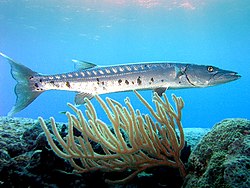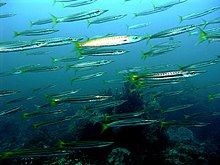| Barracuda Temporal range: Early Eocene to Present[1] | |
|---|---|
 | |
| Great barracuda and jacks, Saba, Netherlands Antilles | |
| Scientific classification | |
| Kingdom: | Animalia |
| Phylum: | Chordata |
| Class: | Actinopterygii |
| Order: | Perciformes |
| Family: | Sphyraenidae Rafinesque, 1815 |
| Genus: | Sphyraena Klein, 1778 |
| Species | |
| See text | |
The barracuda is a ray-finned fish known for its large size and fearsome appearance. Its body is long, fairly compressed, and covered with small, smooth scales. Some species can reach up to 1.8 m (5.9 ft) in length and 30 cm (12 in) in width.[2] The barracuda is a saltwater fish of the genus Sphyraena, the only genus in the family Sphyraenidae, and is found in tropical and subtropical oceans worldwide.
Appearance and physical description

Barracudas are elongated fish, pike-like in appearance, with prominent, sharp-edged, fang-like teeth, much like piranhas, all of different sizes, set in sockets of their large jaws. They have large, pointed heads with an underbite in many species. Their gill covers have no spines and are covered with small scales. Their two dorsal fins are widely separated, with the anterior fin having five spines, and the posterior fin having one spine and 9 soft rays. The posterior dorsal fin is similar in size to the anal fin and is situated above it. The lateral line is prominent and extends straight from head to tail. The spinous dorsal fin is placed above the pelvic fins and is normally retracted in a groove. The caudal fin is moderately forked with its posterior edged double-curved and is set at the end of a stout peduncle. The pectoral fins are placed low on the sides. Its swim bladder is large.
In most cases, a barracuda is dark green, dark blue, or gray on its upper body, with silvery sides and a chalky-white belly. Coloration varies somewhat between species. For some species, irregular black spots or a row of darker cross-bars occur on each side. Their fins may be yellowish or dusky. Barracudas live primarily in oceans, but certain species, such as the great barracuda, live in brackish water.
Some species grow quite large, such as the European barracuda, barracouta, or spet (S. sphyraena), found in the Mediterranean Sea and eastern Atlantic; the great barracuda, picuda or becuna (S. picuda), ranging on the Atlantic coast of tropical America from North Carolina to Brazil and reaching Bermuda. Other barracuda species are found around the world. Examples are the California barracuda (S. argentea), found from Puget Sound southwards to Cabo San Lucas, the Indian barracuda (S. jello), and the black-finned or Commerson's barracuda (S. commersoni), from the seas of India and the Malay Peninsula and Archipelago.
Behavior







Barracudas are voracious, opportunistic predators, relying on surprise and short bursts of speed (up to 27 mph (43 km/h))[3] to overtake their prey.
Adults of most species are more or less solitary, while young and half-grown fish frequently congregate. Barracuda prey primarily on fish (which may include some as large as themselves). They kill and consume larger prey by tearing chunks of flesh.
More Stories: http://Gofishtalk.com
Ambil jackpot jutaan rupiahmu disini hanya dengan 25ribu, Menang nya Gampang Banget
ReplyDeletedapatkan bonus 30% pertama deposit
Agen Poker Terbesar Terpercaya
Agen Poker Online Situs Resmi
Poker Online Uang Asli
Cara Dapat Uang Dengan Cepat
Bandar Ceme Gampang Menang
info lebih lanjut hubungi whatsapp +6283873755078